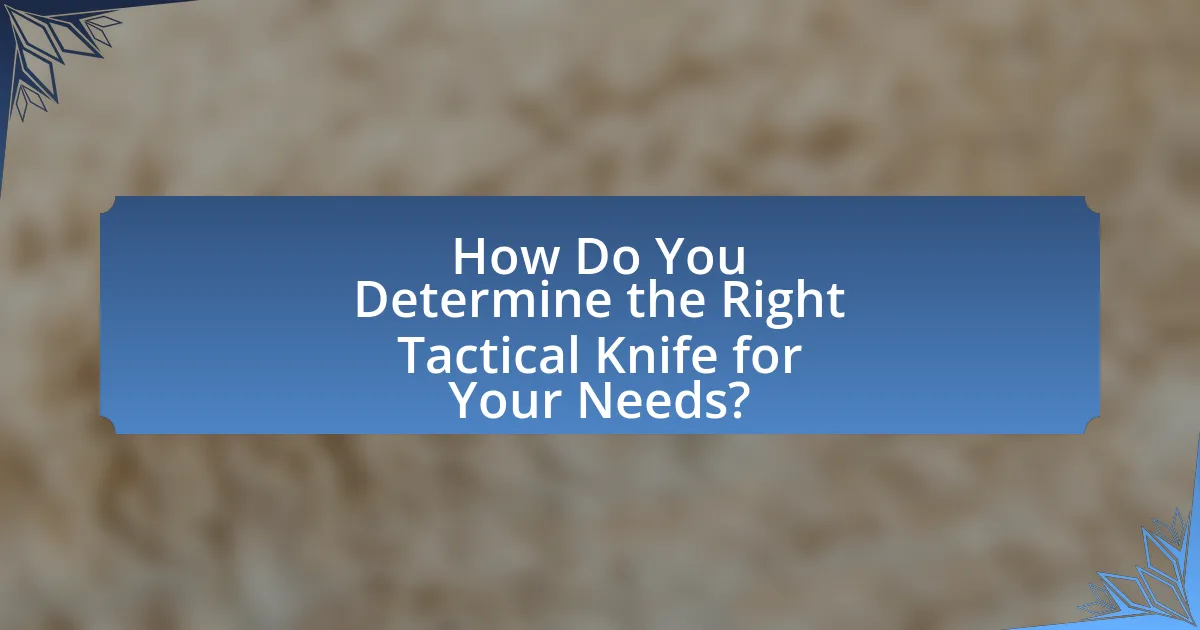Choosing the right tactical knife for outdoor adventures involves careful consideration of several factors, including blade material, size, design, and handle features. Essential characteristics such as durability, ergonomic grip, and reliable locking mechanisms enhance the knife’s performance and safety. The article explores the impact of blade material on performance, the best blade shapes for outdoor use, and the importance of handle design. Additionally, it discusses the significance of knife size in relation to portability and usability, as well as best practices for maintenance and safety during use. Recommended tactical knives for various outdoor activities are also highlighted, providing readers with practical options for their needs.

What Should You Consider When Choosing a Tactical Knife for Outdoor Adventures?
When choosing a tactical knife for outdoor adventures, consider the blade material, size, and design. High-quality stainless steel or carbon steel blades offer durability and edge retention, essential for outdoor tasks. The size should balance portability and functionality; a blade length of 3 to 5 inches is typically versatile for various uses. Additionally, the design should include features like a comfortable grip and a secure locking mechanism to ensure safety during use. These factors collectively enhance the knife’s performance and reliability in outdoor environments.
What are the essential features of a tactical knife?
The essential features of a tactical knife include a durable blade, ergonomic handle, and reliable locking mechanism. A durable blade, often made from high-carbon stainless steel, ensures longevity and resistance to corrosion, making it suitable for various outdoor conditions. An ergonomic handle provides a secure grip, enhancing control during use, which is crucial in tactical situations. Additionally, a reliable locking mechanism prevents accidental blade closure, ensuring safety while the knife is in operation. These features collectively enhance the knife’s functionality and reliability in outdoor adventures.
How does blade material impact performance?
Blade material significantly impacts performance by influencing durability, sharpness retention, and corrosion resistance. High-carbon stainless steel, for example, offers excellent edge retention and resistance to rust, making it ideal for outdoor use. In contrast, softer stainless steels may require more frequent sharpening but can be easier to hone. Additionally, materials like ceramic provide exceptional hardness and lightweight properties, enhancing cutting efficiency but can be brittle under stress. The choice of blade material directly affects how well a tactical knife performs in various outdoor conditions, as evidenced by user reviews and performance tests that highlight the advantages of specific materials in real-world applications.
What blade shapes are best for outdoor use?
Drop point and tanto blade shapes are best for outdoor use. The drop point blade features a convex curve that provides a strong tip for piercing and a broad belly for slicing, making it versatile for various outdoor tasks such as skinning game or preparing food. The tanto blade, characterized by its angular tip and flat edge, excels in piercing and is effective for tactical applications, making it suitable for survival situations. Both blade shapes are favored by outdoor enthusiasts for their durability and functionality in diverse environments.
Why is the knife’s handle important?
The knife’s handle is important because it directly affects the user’s grip, control, and comfort during use. A well-designed handle enhances safety by reducing the risk of slipping, which can lead to accidents. For instance, ergonomic handles made from materials like rubber or textured plastics provide better traction and reduce hand fatigue, allowing for prolonged use without discomfort. Studies have shown that a comfortable grip can improve precision in cutting tasks, making it essential for outdoor adventures where reliability is crucial.
What materials are commonly used for knife handles?
Common materials used for knife handles include wood, plastic, metal, and composite materials. Wood offers a traditional aesthetic and good grip, while plastic, such as polypropylene, is lightweight and resistant to moisture. Metal handles, often made from stainless steel or aluminum, provide durability and strength. Composite materials, like G10 or Micarta, combine various elements to enhance grip and resilience, making them popular in tactical knives. These materials are chosen based on their performance characteristics, such as weight, grip, and resistance to environmental factors, which are crucial for outdoor adventures.
How does handle design affect grip and control?
Handle design significantly affects grip and control by influencing how securely a user can hold the knife and maneuver it during use. A well-designed handle, featuring ergonomic contours and textured surfaces, enhances friction and comfort, reducing the likelihood of slippage even in wet or challenging conditions. For instance, studies have shown that handles with materials like rubber or G10 provide superior grip compared to smooth plastic, allowing for better control during intricate tasks. Additionally, the shape and size of the handle can accommodate various hand sizes, ensuring that users maintain a firm grip, which is crucial for safety and effectiveness in outdoor scenarios.
What role does knife size play in outdoor adventures?
Knife size significantly influences functionality and usability in outdoor adventures. A larger knife can handle heavy-duty tasks such as chopping wood or preparing food, while a smaller knife excels in precision tasks like carving or detailed cutting. For instance, a study by the American Knife and Tool Institute indicates that a blade length of 3 to 5 inches is optimal for versatility in outdoor settings, balancing portability with effectiveness. Thus, selecting the appropriate knife size is crucial for ensuring efficiency and safety during various outdoor activities.
How do different sizes affect portability and usability?
Different sizes of tactical knives significantly impact portability and usability. Smaller knives are generally more portable, allowing for easier carrying in pockets or on belts, which enhances accessibility during outdoor activities. In contrast, larger knives may offer greater usability for tasks requiring more force or leverage, such as chopping or cutting through tougher materials. However, their increased size can hinder portability, making them cumbersome to carry for extended periods. For instance, a study by the American Knife and Tool Institute indicates that knives under 4 inches in blade length are preferred for everyday carry due to their balance of portability and functionality, while blades over 6 inches are often reserved for specific tasks that demand more robust cutting power.
What are the advantages of a compact versus a full-sized knife?
Compact knives offer advantages such as portability and ease of concealment, making them ideal for everyday carry and situations where space is limited. Their smaller size allows for lightweight transport, which is beneficial during outdoor adventures where minimizing gear weight is crucial. In contrast, full-sized knives provide greater cutting power and versatility, suitable for more demanding tasks like heavy-duty chopping or slicing. The larger blade length enhances leverage and control, making them effective for various outdoor applications. Thus, the choice between compact and full-sized knives depends on the specific needs of the user, balancing portability with functionality.

How Do You Determine the Right Tactical Knife for Your Needs?
To determine the right tactical knife for your needs, assess the intended use, blade material, size, and handle design. The intended use dictates the knife’s features; for example, a survival knife requires durability and versatility, while a tactical knife may prioritize quick deployment and ease of carry. Blade materials like stainless steel offer corrosion resistance, while high-carbon steel provides edge retention. Size matters as a longer blade can enhance cutting power, but a shorter blade offers better control. Lastly, the handle design should ensure a secure grip, which is crucial for safety and effectiveness during use. Research indicates that knives with ergonomic handles and textured grips reduce slippage, enhancing user performance in critical situations.
What types of tactical knives are available for outdoor use?
Tactical knives available for outdoor use include fixed-blade knives, folding knives, and multi-tools. Fixed-blade knives are known for their durability and strength, making them ideal for heavy-duty tasks such as chopping and cutting. Folding knives offer portability and convenience, allowing for easy storage and transport while still providing reliable cutting capabilities. Multi-tools combine various functions, including knife blades, pliers, and screwdrivers, making them versatile for a range of outdoor activities. These classifications are supported by their widespread use among outdoor enthusiasts and professionals, highlighting their effectiveness in various outdoor scenarios.
What distinguishes fixed blade knives from folding knives?
Fixed blade knives are characterized by a blade that is permanently fixed to the handle, while folding knives feature a blade that can be folded into the handle for storage and portability. The fixed blade design typically offers greater strength and durability, making it suitable for heavy-duty tasks, as evidenced by their use in survival and tactical scenarios. In contrast, folding knives are often more compact and convenient for everyday carry, appealing to users who prioritize portability.
Which knife types are best suited for specific outdoor activities?
Fixed-blade knives are best suited for outdoor activities such as camping and survival due to their durability and ease of use. These knives, like the Ka-Bar Becker BK2, provide strength for heavy tasks like chopping wood or preparing food. Folding knives, such as the Benchmade Griptilian, are ideal for hiking and everyday carry because they are compact and versatile, making them easy to transport while still effective for tasks like cutting rope or opening packages. Multi-tools, exemplified by the Leatherman Wave, are excellent for backpacking as they combine various tools in one device, allowing for quick access to multiple functions without carrying extra weight. Each knife type is designed to meet specific needs in outdoor settings, ensuring efficiency and safety during various activities.
How do you assess the quality of a tactical knife?
To assess the quality of a tactical knife, evaluate its materials, construction, and performance. High-quality tactical knives typically feature blades made from durable steel, such as AUS-8 or S30V, which offer excellent edge retention and corrosion resistance. The handle should be made from robust materials like G10 or Micarta, providing a secure grip even in wet conditions. Additionally, examine the knife’s design, including blade shape and thickness, as these factors influence its versatility and effectiveness in various tasks. Performance can be tested through cutting, slicing, and overall handling during practical use, ensuring it meets the demands of outdoor adventures.
What certifications or standards should you look for?
When choosing a tactical knife for outdoor adventures, look for certifications such as the ISO 9001 quality management standard and the ASTM F899 standard for knives. ISO 9001 ensures that the manufacturer adheres to consistent quality control processes, which is crucial for reliability in outdoor conditions. The ASTM F899 standard specifically addresses the performance and safety of knives, providing guidelines for materials and construction. These certifications indicate that the knife has undergone rigorous testing and meets industry standards for durability and safety, making them essential factors in your selection process.
How can user reviews inform your decision?
User reviews can significantly inform your decision by providing firsthand insights into the performance and reliability of tactical knives. These reviews often highlight specific features, such as blade durability, ease of use, and overall functionality in outdoor settings, which are crucial for making an informed choice. For instance, a study published in the Journal of Consumer Research found that 79% of consumers trust online reviews as much as personal recommendations, indicating the weight user experiences carry in the decision-making process. By analyzing both positive and negative feedback, potential buyers can gauge the suitability of a knife for their specific outdoor needs, ensuring they select a product that meets their expectations and requirements.

What Are the Best Practices for Using and Maintaining Your Tactical Knife?
The best practices for using and maintaining your tactical knife include proper handling, regular cleaning, and appropriate storage. When using a tactical knife, always ensure a firm grip and use it for its intended purpose to prevent accidents. After each use, clean the blade with warm, soapy water and dry it thoroughly to prevent rust and corrosion, as moisture can lead to deterioration. Additionally, regularly oil the pivot points and blade to maintain smooth operation and protect against wear. Store the knife in a dry place, preferably in a sheath or protective case, to avoid damage and ensure longevity. These practices are essential for preserving the knife’s functionality and extending its lifespan.
How can you ensure the longevity of your tactical knife?
To ensure the longevity of your tactical knife, regularly clean and maintain it. Cleaning involves removing dirt, debris, and moisture after each use, which prevents corrosion and damage to the blade and handle. Additionally, applying a light coat of oil to the blade can protect against rust and maintain sharpness. Proper storage in a dry environment, away from extreme temperatures, also contributes to the knife’s durability. Regularly checking for any signs of wear or damage allows for timely repairs, further extending the knife’s lifespan.
What cleaning and maintenance routines should you follow?
To maintain a tactical knife effectively, you should regularly clean the blade, lubricate moving parts, and inspect for damage. Cleaning involves wiping the blade with a soft cloth and using warm, soapy water for any residue, ensuring that the knife is dried thoroughly to prevent rust. Lubrication should be applied to pivot points and any moving parts with a suitable knife oil to ensure smooth operation. Regular inspections for nicks, chips, or any signs of wear are crucial, as they can affect performance and safety. Following these routines helps prolong the knife’s lifespan and ensures optimal functionality during outdoor adventures.
How do you properly sharpen a tactical knife?
To properly sharpen a tactical knife, use a sharpening stone or a guided sharpening system to maintain the blade’s edge. Begin by selecting the appropriate grit; a coarse grit (around 200-400) is ideal for reshaping the edge, while a finer grit (1000-3000) is suitable for honing. Hold the knife at a consistent angle, typically between 15 to 20 degrees, and apply even pressure while moving the blade across the stone in a sweeping motion. This technique ensures that the edge is sharpened uniformly. Regular maintenance, including honing after each use, will prolong the knife’s sharpness and effectiveness.
What safety tips should you keep in mind while using a tactical knife?
When using a tactical knife, always prioritize safety by keeping the blade pointed away from your body and others. This practice minimizes the risk of accidental cuts or injuries. Additionally, ensure that the knife is properly maintained, with a sharp blade and secure handle, as dull knives can slip and cause accidents. Always use the knife in a well-lit area to enhance visibility and control during use. Furthermore, avoid using the knife for unintended purposes, such as prying or twisting, which can lead to breakage and potential injury. Lastly, store the knife safely when not in use, preferably in a sheath or designated holder, to prevent accidental contact.
How can you prevent accidents during outdoor activities?
To prevent accidents during outdoor activities, individuals should prioritize thorough preparation and safety measures. This includes conducting a risk assessment of the environment, ensuring proper equipment is used, and adhering to safety guidelines. For instance, wearing appropriate gear, such as helmets and protective clothing, significantly reduces the likelihood of injury. According to the National Safety Council, proper safety equipment can decrease the risk of accidents by up to 50%. Additionally, staying informed about weather conditions and potential hazards in the area can further enhance safety.
What should you do in case of an injury related to knife use?
In case of an injury related to knife use, immediately apply direct pressure to the wound to control bleeding. If the bleeding does not stop, elevate the injured area above the heart and continue applying pressure. For deeper cuts, clean the wound with water and apply a sterile bandage. If the injury is severe, such as deep lacerations or if the person shows signs of shock, seek emergency medical assistance promptly. According to the American College of Surgeons, timely intervention can significantly reduce complications from knife injuries.
What are some recommended tactical knives for outdoor adventures?
Some recommended tactical knives for outdoor adventures include the ESEE Izula II, the Benchmade Griptilian, and the Ka-Bar Becker BK2. The ESEE Izula II is known for its durability and lightweight design, making it ideal for various outdoor tasks. The Benchmade Griptilian features a versatile blade and ergonomic handle, providing comfort and control during use. The Ka-Bar Becker BK2 is recognized for its robust construction and ability to handle heavy-duty tasks, making it a reliable choice for outdoor enthusiasts. These knives are favored for their performance, reliability, and suitability for outdoor environments.


